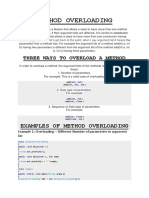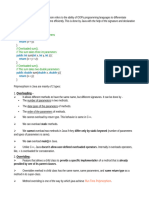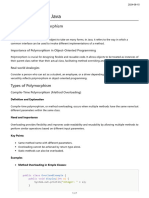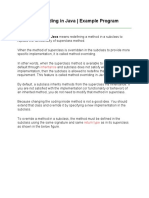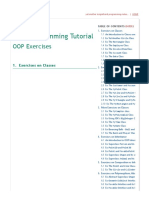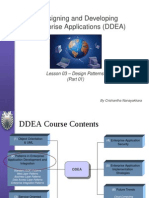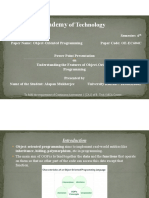0 ratings0% found this document useful (0 votes)
207 viewsMethod Overloading and Method Overriding in Java
This document discusses the differences between method overloading and method overriding in Java. Method overloading involves defining multiple methods with the same name but different parameters within a class, while method overriding involves redefining an existing method from a parent class within a child class. The key differences are that method overloading relies on static binding and occurs within a class, while method overriding uses dynamic binding and occurs between classes in an inheritance hierarchy.
Uploaded by
titobesaleelCopyright
© © All Rights Reserved
Available Formats
Download as PDF, TXT or read online on Scribd
0 ratings0% found this document useful (0 votes)
207 viewsMethod Overloading and Method Overriding in Java
This document discusses the differences between method overloading and method overriding in Java. Method overloading involves defining multiple methods with the same name but different parameters within a class, while method overriding involves redefining an existing method from a parent class within a child class. The key differences are that method overloading relies on static binding and occurs within a class, while method overriding uses dynamic binding and occurs between classes in an inheritance hierarchy.
Uploaded by
titobesaleelCopyright
© © All Rights Reserved
Available Formats
Download as PDF, TXT or read online on Scribd
You are on page 1/ 3
Difference Between Method Overloading And Method
Overriding In Java
PRAMODBABLAD FEBRUARY 2, 2015 POLYMORPHISM 5 COMMENTS
What is the difference between method overloading and method
overriding in java?
Method overloading and method overriding are two important java concepts which allows java programmer to define the methods with
same name but different behavior. Both method overloading and method overriding shows polymorphism. It is also one of the most
asked java interview question for freshers. In this article, I have tried to list out the differences between method overloading and
method overriding in java. You can also go through the some basics about method overloading and method overriding in
java here and here.
Method Overloading Method Overriding
When a class has more than one
When a super class method is
method with same name but with
Definition modified in the sub class, then we
different arguments, then we call it
call this as method overriding.
as method overloading.
Overloaded methods must have Overridden methods must have
different method signatures. That same method signature. I.e. you
means they should differ at least in must not change the method
Method Signature any one of these three things – name, types of arguments, number
Number of arguments, Types of of arguments and order of
arguments and order of arguments. arguments while overriding a
But, they must have same name. super class method.
The return type of the overridden
method must be compatible with
that of super class method. That
means if super class method has
primitive type as its return type,
Overloaded methods can have
Return Types then it must be overridden with
same or different return types.
same return type. If super class
method has derived type as its
return type then it must be
overridden with same type or its
sub class type.
While overriding a super class
method either you can keep the
Visibility(private, public, Overloaded methods can have
same visibility or you can increase
protected and default) same visibility or different visibility.
the visibility. But you can’t reduce
it.
Overloaded methods can be static
Static Context or not static. It does not affect the You can’t override a static method.
method overloading.
Binding between method call and Binding between method call and
Binding method definition happens at method definition happens at run
compile time (Static Binding). time (Dynamic Binding).
Polymorphism It shows static polymorphism. It shows dynamic polymorphism.
Private methods can be Private methods can’t be
Private methods
overloaded. overridden.
Final Methods Final methods can be overloaded. Final methods can’t be overridden.
For method overriding, two classes
For method overloading, only one are required – super class and
Class Requirement class is required. I.e. Method sub class. That means method
overloading happens within a class. overriding happens between two
classes.
Method Overloading Example :
1 public class MainClass
2 {
3 static String concateString(String s1, String s2)
4 {
5 return s1+s2;
6 }
7
8 static String concateString(String s1, String s2, String s3)
9 {
10 return s1+s2+s3;
11 }
12
13 static String concateString(String s1, String s2, String s3, Strin
14 {
15 return s1+s2+s3+s4;
16 }
17
18 public static void main(String[] args)
19 {
20 concateString("ONE", "TWO");
21
22 concateString("ONE", "TWO", "THREE");
23
24 concateString("ONE", "TWO", "THREE", "FOUR");
25 }
26 }
Method Overriding Example :
1 class SuperClass
2 {
3 void SuperClassMethod()
4 {
5 System.out.println("SUPER CLASS METHOD");
6 }
7 }
8
9 class SubClass extends SuperClass
10 {
11 @Override
12 void SuperClassMethod()
13 {
14 System.out.println("SUPER CLASS METHOD IS OVERRIDDEN");
15 }
16 }
You might also like
- Spring Boot Annotations With Examples - JavaTechOnline100% (1)Spring Boot Annotations With Examples - JavaTechOnline13 pages
- Method Overloading Vs Method Overriding in JavaNo ratings yetMethod Overloading Vs Method Overriding in Java4 pages
- Method Overloading: Argument Lists Could Differ inNo ratings yetMethod Overloading: Argument Lists Could Differ in9 pages
- Difference Between Method Overloading and Overriding in Java PDFNo ratings yetDifference Between Method Overloading and Overriding in Java PDF14 pages
- Method Overloading and Overriding in Java(6752)No ratings yetMethod Overloading and Overriding in Java(6752)9 pages
- 130 Slides OOP Part 1 Inheritance Method Overloading Vs Overriding RecapNo ratings yet130 Slides OOP Part 1 Inheritance Method Overloading Vs Overriding Recap15 pages
- Overloading Vs Overriding: Ionut SpalateluNo ratings yetOverloading Vs Overriding: Ionut Spalatelu9 pages
- Difference Between Method Overloading and MethodNo ratings yetDifference Between Method Overloading and Method1 page
- Difference Between Method Overloading and Method Overriding in JavaNo ratings yetDifference Between Method Overloading and Method Overriding in Java2 pages
- Method Overloading: Three Ways To Overload A MethodNo ratings yetMethod Overloading: Three Ways To Overload A Method6 pages
- Java1608: Polymorphism Based On Overloaded Methods: R.G. (Dick) BaldwinNo ratings yetJava1608: Polymorphism Based On Overloaded Methods: R.G. (Dick) Baldwin9 pages
- Q8. What Is Method Overloading and Method Overriding?: Let's Take A Look at The Example Below To Understand It BetterNo ratings yetQ8. What Is Method Overloading and Method Overriding?: Let's Take A Look at The Example Below To Understand It Better2 pages
- Difference Between Overloading and Overriding Difference Between Static & Dynamic PolymorphismNo ratings yetDifference Between Overloading and Overriding Difference Between Static & Dynamic Polymorphism1 page
- Overloading and Overriding in SalesforceNo ratings yetOverloading and Overriding in Salesforce5 pages
- Java Polymorphism in OOP's With ExampleNo ratings yetJava Polymorphism in OOP's With Example17 pages
- Presentation On Method Overloading and Overriding100% (1)Presentation On Method Overloading and Overriding17 pages
- WINSEM2024-25_BCSE103E_ETH_VL2024250506070_2025-02-06_Reference-Material-INo ratings yetWINSEM2024-25_BCSE103E_ETH_VL2024250506070_2025-02-06_Reference-Material-I14 pages
- Method Hiding in Java and Overridning DifferenceNo ratings yetMethod Hiding in Java and Overridning Difference7 pages
- Polymorphism: Application Programming: Java ProgrammingNo ratings yetPolymorphism: Application Programming: Java Programming14 pages
- Java Technical Write-UP: Topic: - Method Overloading & Method OverridingNo ratings yetJava Technical Write-UP: Topic: - Method Overloading & Method Overriding6 pages
- Lecture - 2 Method Overloading, Inheritance and Method OverridingsNo ratings yetLecture - 2 Method Overloading, Inheritance and Method Overridings69 pages
- Method Overriding in Java - Example ProgramNo ratings yetMethod Overriding in Java - Example Program19 pages
- A123845432 - 23641 - 31 - 2019 - Module 9 PolymorphismNo ratings yetA123845432 - 23641 - 31 - 2019 - Module 9 Polymorphism15 pages
- Students Should Understand Concept of Dispatch Methodfinal Method and Use of Super .No ratings yetStudents Should Understand Concept of Dispatch Methodfinal Method and Use of Super .3 pages
- Mastering Java: A Golden Collection of Questions & Answers for Success: Java: 200 Key Questions for a strong programming baseFrom EverandMastering Java: A Golden Collection of Questions & Answers for Success: Java: 200 Key Questions for a strong programming baseNo ratings yet
- 100 Days of Coding in Python - carrulloNo ratings yet100 Days of Coding in Python - carrullo282 pages
- Learn Java - Conditionals and Control Flow Cheatsheet - CodecademyNo ratings yetLearn Java - Conditionals and Control Flow Cheatsheet - Codecademy3 pages
- How To Start Coding - The Ultimate Guide For Beginner ProgrammersNo ratings yetHow To Start Coding - The Ultimate Guide For Beginner Programmers22 pages
- 10 Best C and C++ Books For Beginners & Advanced ProgrammersNo ratings yet10 Best C and C++ Books For Beginners & Advanced Programmers12 pages
- Advanced SQL Queries, Examples of Queries in SQL List of TOP-70 Items in 2022 - ByteScoutNo ratings yetAdvanced SQL Queries, Examples of Queries in SQL List of TOP-70 Items in 2022 - ByteScout19 pages
- SQL Commands - DML, DDL, DCL, TCL, DQL With Query ExampleNo ratings yetSQL Commands - DML, DDL, DCL, TCL, DQL With Query Example9 pages
- UML Aspect Specification Using Role ModelsNo ratings yetUML Aspect Specification Using Role Models6 pages
- Internship Assignment 5: Name: Sudeshna Acharyya EmailNo ratings yetInternship Assignment 5: Name: Sudeshna Acharyya Email10 pages
- Class Cls - Name Definition Create Private. ... EndclassNo ratings yetClass Cls - Name Definition Create Private. ... Endclass17 pages
- C++: How Does RAII Work When A Constructor Throws An Exception?No ratings yetC++: How Does RAII Work When A Constructor Throws An Exception?2 pages
- ICT Computer-Programming Java SHS Q3 LAS1 FINALNo ratings yetICT Computer-Programming Java SHS Q3 LAS1 FINAL10 pages
- Adapter Classes: The Adapter Classes Are Found in Java - Awt.event, Java - Awt and and Javax - Swing.event PackagesNo ratings yetAdapter Classes: The Adapter Classes Are Found in Java - Awt.event, Java - Awt and and Javax - Swing.event Packages13 pages
- Submitted by - Under The Guidance of - Palash Chaturvedi Mr. Manoj Lukose Class - XII A Roll No - 1673783No ratings yetSubmitted by - Under The Guidance of - Palash Chaturvedi Mr. Manoj Lukose Class - XII A Roll No - 167378339 pages
- 20120224170209MTS 3033 - Bab1 Introduction To OOPNo ratings yet20120224170209MTS 3033 - Bab1 Introduction To OOP41 pages
- IOS Interview Questions (Swift) - Part 3 - Animesh Mishra - MediumNo ratings yetIOS Interview Questions (Swift) - Part 3 - Animesh Mishra - Medium6 pages
- C++ Tutorial Part II - Advanced: Silan LiuNo ratings yetC++ Tutorial Part II - Advanced: Silan Liu53 pages
- C++1x-2x Special Member Func Ons: Compiler Implicitly DeclaresNo ratings yetC++1x-2x Special Member Func Ons: Compiler Implicitly Declares1 page
- Define OOP.: Unit I - Introduction To Oop and Fundamentals of JavaNo ratings yetDefine OOP.: Unit I - Introduction To Oop and Fundamentals of Java27 pages
- Subject Code: 82866 Subject Name: Java Programming Common Subject Code (If Any)No ratings yetSubject Code: 82866 Subject Name: Java Programming Common Subject Code (If Any)8 pages













